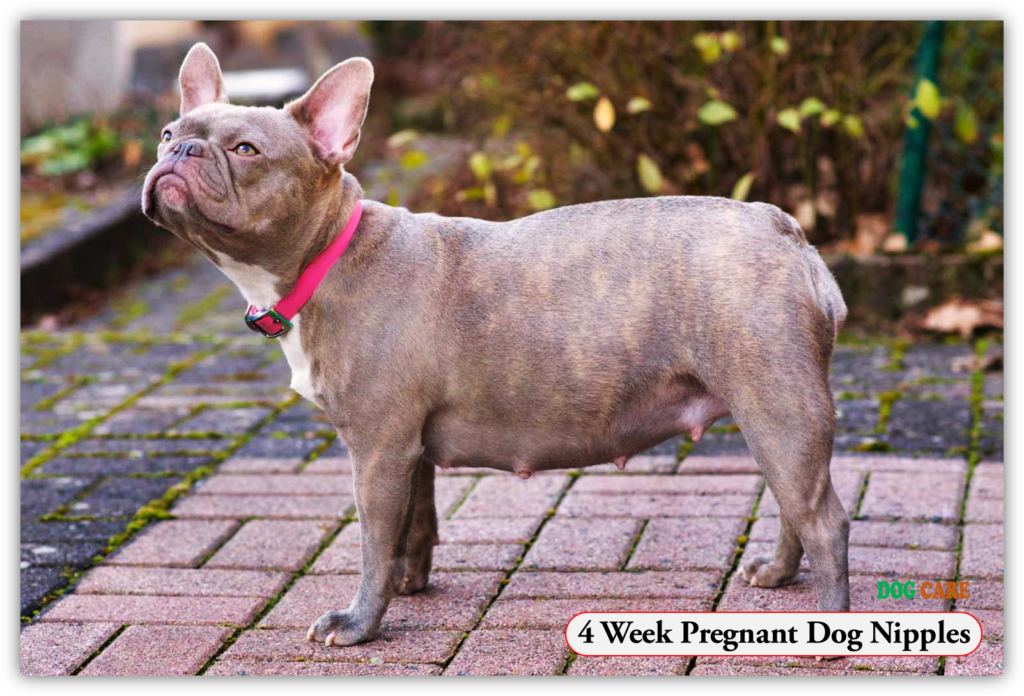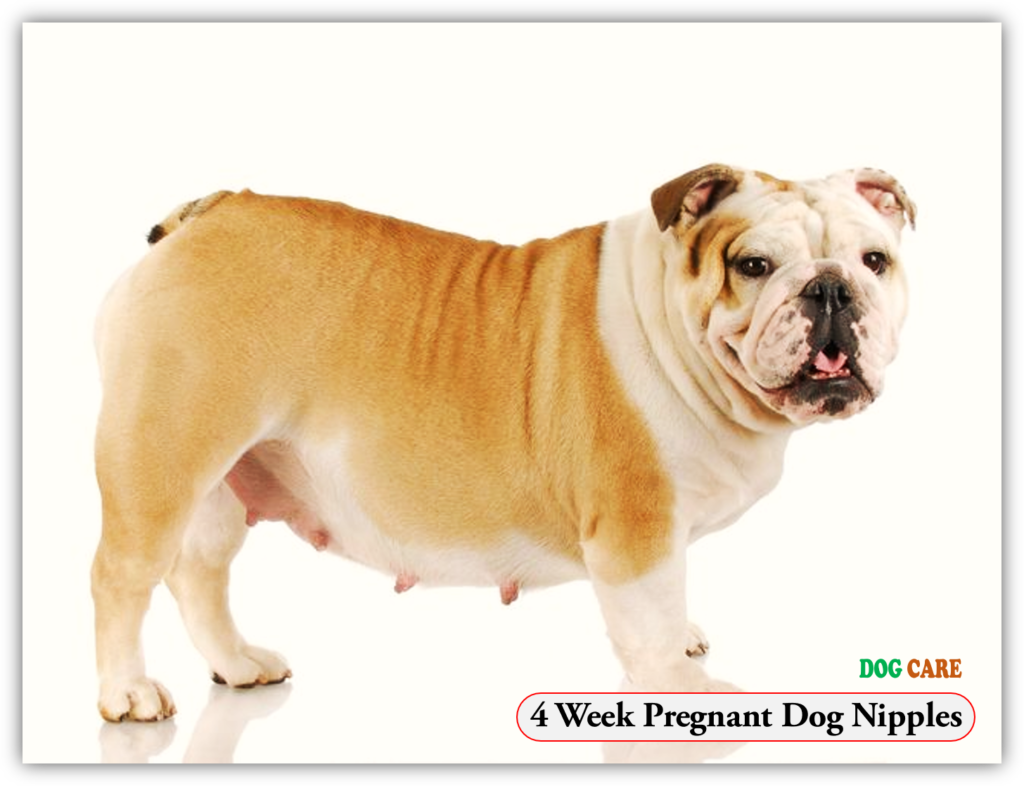4 Week Pregnant Dog Nipples – At four weeks pregnant, a dog’s nipples become larger and may darken in color. This change indicates the progression of her pregnancy.
Understanding the subtle changes in a dog’s body is essential for responsible pet owners. At the one-month mark of canine pregnancy, the dog’s nipples are often one of the earliest physical signs that she is expecting. The nipples will appear more prominent and might exhibit a change in pigmentation, preparing for the eventual need to nurse puppies.
Noticing these changes early on can help an owner provide the necessary care and nutrition that a pregnant dog requires. This development is a critical indicator for breeders and pet owners alike, ensuring that preparations are made for a safe and healthy delivery. With careful monitoring, the physical transformation of a dog’s nipples at four weeks pregnant provides a clear signal of the exciting developments to come.

Introduction To Canine Pregnancy
An enchanting journey begins within the life of a female dog when she enters the fascinating phase of canine pregnancy. At four weeks pregnant, subtle yet significant changes emerge, hinting at the new lives growing within. For pet owners and breeders alike, understanding these transformations is crucial for providing the best care to expectant mothers. This guide unveils the nuances of canine pregnancy, particularly focusing on the indicators such as the changes in dog nipples and the maternal transformations accompanying this natural process.
Understanding The Canine Estrous Cycle
Before delving into the signs of pregnancy, one must grasp the intricacies of the canine estrous cycle. This reproductive cycle entails several stages:
- Proestrus: The initial phase marked by an increase in estrogen levels and the beginning of the receptive period.
- Estrus: Ovulation occurs, and the female dog is receptive to males.
- Diestrus: The stage following mating, where the body prepares for pregnancy or returns to normal if no mating occurred.
- Anestrus: A period of reproductive dormancy before the cycle begins anew.
Recognizing which stage your dog is in can provide valuable insight into her fertile windows and aid in successful breeding or pregnancy prevention.
The Early Stages Of Dog Pregnancy
As pregnancy progresses, a dog’s body undergoes multiple changes, particularly during the early stages. One notable sign is the enlargement and color change of the nipples, which become more prominent and may develop a darker hue. It is essential to periodically monitor these physical alterations for they often serve as the first hints of gestation.
Additional changes during the initial four weeks may include:
- A slight increase in body weight.
- Mild behavioral variations like increased affection or lethargy.
- Possible morning sickness due to hormonal fluctuations.
Importance Of Recognizing Pregnancy Signs In Dogs
Detecting the signs of pregnancy early in dogs plays a pivotal role in ensuring a healthy pregnancy. Early recognition allows for timely veterinary consultations, proper nutritional adjustments, and suitable exercise plans. Observing the changes in dog nipples is among the first tasks, as it paves the way for further care and attention that the expectant mother will require.
Some critical reasons to stay alert for pregnancy signs include:
- Customizing the dog’s diet to support fetal development.
- Adjusting the exercise routine to avoid overexertion.
- Preparing for the possibility of complications that may require medical attention.
Responsible pet ownership and breeding require a solid understanding of these early pregnancy indicators, ensuring that both mother and future puppies receive the utmost care.
Week-by-week Dog Pregnancy Overview
Welcome to the remarkable journey of canine gestation! For dog owners, understanding the week-by-week progress of dog pregnancy can help in providing the best care for the expecting mother. At 4 weeks pregnant, a dog’s body starts showing subtle changes as it nurtures new life. This period is pivotal and tracks the transition from conception to the fascinating milestones in the first month of pregnancy. Let’s explore the canine pregnancy calendar to ensure you are well-prepared for the arrival of adorable little puppies.
Overview Of The 63-day Gestation Period
The typical gestation period for a dog is approximately 63 days, a magical time filled with significant developmental stages. This spans over roughly nine weeks, each holding its distinct markers and developmental cues as embryos transform into full-term puppies. Owners will observe physical and behavioral changes in their dogs as they progress through the trimesters, with week four often being a telltale sign as the mother’s body adapts to the growing litter.
Milestones In The First Month Of Dog Pregnancy
- Week 1 & 2: Fertilization occurs, and the embryos travel to the uterus.
- Week 3: Embryos implant into the uterine lining, and the placenta begins to form.
- Week 4: Dog nipples become more pronounced, which is one of the first visible signs of pregnancy. The fetuses are now well embedded in the uterus.
| Week | Milestone | Description |
|---|---|---|
| 1-2 | Conception | Fertilized eggs travel and settle in the uterus. |
| 3 | Implantation | Embryos implant, placenta starts forming. |
| 4 | Nipple Changes | Nipples swell and become more evident as pregnancy progresses. |
As you proceed into the second month, expect more pronounced changes in appetite, behavior, and abdomen size—signaling the continued growth and development of the puppies. Regular veterinary check-ups become essential to monitor the health of the mother and the progression of the pregnancy.
Physical Changes In A 4 Week Pregnant Dog
The journey of pregnancy in dogs is a beautiful process culminating in the miracle of new life. By the time your dog reaches four weeks of gestation, her body begins to exhibit tell-tale signs indicating the progression of her pregnancy. Recognizing these changes early on is crucial for providing proper care. Understanding the physical transformations that occur, including nipple and coat changes as well as behavioral adjustments, can help ensure the well-being of the expectant mother and her future puppies.
Nipple Changes And What To Look For
At around four weeks, a pregnant dog’s nipples become more prominent as part of her body’s preparations for nourishing newborn puppies. Notable changes include:
- Size: An evident increase in nipple size is common as the mammary glands start to develop.
- Color: There may be a noticeable darkening of the nipples due to increased blood flow and hormonal shifts.
- Texture: Nipples may appear more pronounced and can even have a swollen or slightly engorged look to them.
Keep an eye out for these modifications, and consult a veterinarian if any nipple changes raise concerns or appear abnormal. This proactive step is important in ruling out potential health issues unrelated to pregnancy.
Coat And Behavioral Changes During Early Pregnancy
Beyond physical alterations, a pregnant dog may also experience shifts in both her coat’s condition and her behavior as pregnancy hormones influence her body. These are sometimes less noticeable but still significant signs of pregnancy.
| Aspect | Changes Observed |
|---|---|
| Coat | A lustrous sheen may start to manifest, thanks to hormonal adjustments. However, some dogs may display the opposite, with their coat appearing duller. |
| Behavior | Moods swings, nesting, and a decrease in physical activity are common behaviors during this stage of pregnancy. Dogs may seek quiet and private places more often. |
It is vital to monitor these signs closely and provide a comfortable environment for your furry companion. A nutritious diet, plenty of freshwater, and a serene area for rest are key elements in nurturing an expecting dog. Remember that these external changes are a reflection of the significant internal developments as your dog’s body readies itself to bring new puppies into the world.
Understanding Nipple Development In Pregnant Dogs
As a dog owner or breeder, observing the physiological changes in a pregnant dog can be both fascinating and critical for ensuring proper care. Among the myriad of changes, nipple development is a clear and early sign of pregnancy. Around the 4-week mark, noticeable changes occur in the appearance, texture, and color of the nipples, signifying the body’s preparation for nursing.
How Dog Nipples Change During Pregnancy
Dog nipples undergo significant transformation throughout pregnancy. Initially, they may appear larger and more prominent as blood flow increases. This is a natural part of the body’s preparation for milk production. Owners might also observe the following:
- Darker pigmentation, making the nipples stand out more against the dog’s fur.
- A swelling or puffiness, caused by the underlying mammary gland’s growth.
- Increased nipple sensitivity, which could make the dog more protective of her belly.
- Development of the surrounding mammary glands, felt as soft lumps under the skin.
Comparing Nipple Changes In Pregnant And Non-pregnant Dogs
Distinguishing between the nipple changes in pregnant and non-pregnant dogs is vital for early pregnancy detection. While non-pregnant dogs have relatively small and light-colored nipples, the significant changes in a pregnant dog start from around the 4-week mark. Here’s a comparison:
| Pregnant Dogs | Non-Pregnant Dogs |
|---|---|
| Enlarged and more pronounced nipples | Small and less prominent nipples |
| Darker pigmentation | Lighter or unchanged coloration |
| Swollen mammary glands | No swelling or growth |
| Increased sensitivity and protectiveness | Typical behavior regarding the belly area |
By closely monitoring these changes, owners can better prepare for the upcoming litter and provide the necessary support throughout their dog’s pregnancy journey.
Health Considerations For Pregnant Dogs
As your beloved canine friend enters the fourth week of pregnancy, special attention to her health becomes increasingly important. This is a crucial time for fetal development and changes in the dog’s body, such as the noticeable enlargement of her nipples, are becoming apparent. Ensuring her well-being will reflect directly on the health of the puppies. Here are the key considerations for nutrition and veterinary care during this delicate stage.
Nutrition And Diet For A 4-week Pregnant Dog
Proper nutrition lays the foundation for a healthy pregnancy. At four weeks, your dog’s appetite may increase as she is nourishing not just herself but her growing puppies as well. It’s essential to provide a balanced diet that is rich in proteins, fats, and critical nutrients:
- Folic Acid: Vital for preventing birth defects.
- Calcium: Important for the development of healthy bones and teeth in puppies.
- DHA: A type of Omega-3 fatty acid crucial for brain development.
Always choose high-quality puppy food as it’s formulated to support gestation and growth. An adjustment in meal portions and frequency might also be necessary. Your veterinarian can provide a tailored feeding plan.
Veterinary Care And Prenatal Check-ups
Regular veterinary visits are imperative for monitoring the health of your expectant pet. Around the fourth week of pregnancy, a vet might recommend a prenatal check-up that could include:
- Ultrasound: To confirm pregnancy and assess the health of the fetuses.
- Blood tests: To ensure the mother does not have any underlying conditions that may affect pregnancy.
- Nutrient level evaluation: To adjust dietary requirements if necessary.
It’s also time to discuss a birthing plan and recognize signs of potential complications. Continuous monitoring and professional care are key to navigating through a dog’s pregnancy safely and ensuring optimal health for both the mother and her puppies.
Spotting The Signs Early
Welcoming new life into the world is always a momentous occasion, and spotting the early signs of pregnancy in your canine companion is crucial to providing her with the care she needs. Around the 4-week mark, your dog’s nipples can herald the onset of pregnancy, giving you a visible clue that it’s time to start preparing. Vigilance during this early stage ensures that both the expectant mother and her future puppies receive optimal support for a healthy pregnancy journey.
Recognizing Early Pregnancy In Dogs
As pet owners, recognizing the signs of early pregnancy in dogs is vital for the upcoming weeks of prenatal care. By week four, notable changes become evident:
- Nipple changes: Expect to notice an increase in size and a more vivid pink coloration.
- Behavioral shifts: Your dog may exhibit more affectionate or, conversely, more reclusive behavior.
- Appetite swings: Dogs in early pregnancy might show a surge or a decrease in their appetite.
- Minimal weight gain: Although it might be slight, a gain in weight is often observable.
Consistent observation of these symptoms can confirm suspicions of pregnancy and prompt a visit to the vet for a definitive diagnosis.
The Importance Of Early Detection For Proper Care
Detecting pregnancy early in dogs is not merely about satisfying curiosity; it holds significant implications for prenatal care. Benefits of early detection include:
| Early Sign | Importance |
|---|---|
| Nipple Development | Signals hormonal changes and helps in tracking pregnancy progression. |
| Behavioral Changes | Provides clues for the need of a more peaceful environment for the expectant mother. |
| Appetite Changes | Allows adjustments in diet to meet the nutritional needs of the mother and developing puppies. |
| Weight Gain | Understanding the expected weight gain helps prevent obesity which can complicate the pregnancy. |
Early detection allows breeders and pet owners alike to ensure the mother receives the right prenatal supplements and care, leading to healthy puppies and a smooth labor. Scheduling regular veterinary check-ups, preparing a proper whelping environment, and tailoring nutrition to the mother’s changing needs become much more manageable with early awareness.
With attentive care and a watchful eye on these telltale signs, pet owners can ensure they are doing everything possible for a successful pregnancy. Understanding that around the 4-week mark your dog’s refined physique is whispering the secrets of the life it’s nurturing, allows for proactive measures, guaranteeing the best start for the new litter.
Behavioral Signs Of Pregnancy In Dogs At 4 Weeks
As your beloved canine companion reaches the four-week mark of her pregnancy, you may begin to notice some subtle yet distinct behavioral changes. Dog pregnancy symptoms are not just physical; they also encompass a variety of behavioral signals that indicate your dog is preparing for motherhood. One such change is the transformation in the appearance of your dog’s nipples. During this stage, a pregnant dog’s nipples become more pronounced and may begin to darken due to increased blood flow, preparing for the vital role of nurturing her upcoming litter.
Changes In Appetite And Energy Levels
Paying close attention to your dog’s eating habits and energy levels provides significant clues about her pregnancy. At four weeks, you may observe:
- Increase in appetite: Your dog might show a heightened interest in her meals as her nutritional needs grow with the developing puppies.
- Fluctuating energy levels: Some days, she may appear more lethargic or less interested in physical activities, which is her body’s way of conserving energy for the pregnancy.
Mood Swings And Nesting Behaviors
Dogs, much like humans, can experience mood swings during pregnancy. A usually exuberant dog may seek solitude, while a more reserved dog might seek extra attention. These emotional shifts are normal but should be monitored to ensure they are not signs of underlying health issues.
Additionally, as whelping draws near, nesting behavior often becomes evident. This innate behavior includes:
- Finding a secure and quiet place to give birth.
- Gathering blankets or toys to create a comfortable birthing area.
These behavioral changes in your four-week pregnant dog are signs that her body is preparing for the arrival of her puppies. Offering a supportive and calm environment can help her navigate through these changes with ease.
Preparing For The Arrival Of Puppies
Expectant canine mothers show physical changes as they approach the four-week mark. One of the first signs is the transformation of the dog’s nipples, as the body readies for the nurturing demands of a litter. As an owner, recognizing these changes serves as a cue to start preparations for the upcoming birth. Setting up a conducive environment and opting to provide the necessary support can significantly ease your dog’s pregnancy journey, ensuring a safe delivery and healthy puppies.
Setting Up A Whelping Box
Creating a comfortable area for your dog to give birth is crucial. The whelping box should be spacious enough for your dog to move around and should have sides tall enough to safely contain the newborn puppies. Here are some tips for setting up the perfect whelping area:
- Size: Ensure the box is large enough for your dog to stretch out completely. A general rule of thumb is to allow an additional 12 inches on all sides beyond your dog’s length.
- Materials: Use sturdy, easy-to-clean materials for the box, such as wood or heavy cardboard.
- Comfort: Line the bottom with blankets or towels for padding and easy cleaning.
- Heat: Maintain a warm environment, especially critical in the first weeks of the puppies’ lives. Heat lamps or pads can be beneficial.
- Privacy: Position the box in a quiet area of your home to minimize stress for the mother.
The Role Of The Owner In Supporting The Pregnant Dog
Owner support is integral throughout the pregnancy. Your responsibilities include:
- Nutrition: Provide a balanced diet rich in nutrients; consult with a vet for a feeding plan suitable for pregnant dogs.
- Exercise: Keep your dog active but avoid strenuous activities; gentle walks are beneficial.
- Veterinary Care: Regular check-ups ensure the health of both mother and puppies. Discuss vaccinations, deworming, and any necessary supplements with your vet.
- Monitoring: Watch for any changes in behavior or health issues. Increased nipple size is a common indicator of pregnancy progression.
- Comfort: Provide a stress-free environment and be available for reassurance when labor begins.
Support and preparation go a long way in ensuring the well-being of your pregnant dog. Pay close attention to nipple development around the four-week mark, as it signals the time to step up your involvement and setup for the forthcoming pups.
Common Concerns And Questions From Dog Owners
As your furry companion enters the early stages of pregnancy, a myriad of questions may spring to mind, especially regarding physical changes and health concerns. At four weeks pregnant, dog nipples become a topic of particular interest and sometimes concern for many dog owners. Understanding what’s normal and when to seek veterinary advice can offer peace of mind during this critical stage in your dog’s gestation period.
Expected Body Changes And When To Worry
As pregnancy progresses, visible changes to your dog’s nipples are completely natural. Initial signs include:
- Swelling: Nipples become larger and may protrude more.
- Color changes: Nipple color may darken due to increased blood flow.
- Development of mammary glands: These become more pronounced as she prepares for milk production.
While these are standard changes, there are signs that require immediate veterinary attention:
- Excessive swelling or redness: Could indicate mastitis or infection.
- Discharge from the nipples: Unusual discharge outside of the late pregnancy stage might be a cause for concern.
- Persistent licking or discomfort: Indicates potential issues that warrant veterinary evaluation.
Dealing With False Pregnancies
False pregnancies, or pseudopregnancies, can mimic true pregnancy symptoms in dogs, including nipple changes. Here’s how to deal with the situation:
- Observation: Monitor your dog for signs of psychological or physical distress.
- Comfort: Provide a quiet environment and avoid stimulating the mammary glands.
- Consultation: If symptoms persist or cause concern, consult your veterinarian for the best course of action.
False pregnancies typically resolve on their own, but it’s crucial to support your pet’s physical and emotional needs throughout the process.
Conclusion: Continued Care For The Expectant Mother
As your beloved canine companion enters the 4th week of pregnancy, her body undergoes significant changes, including the development of noticeable nipples as a preparation for the nursing period. Caring for a pregnant dog requires attentiveness, love, and understanding of her needs as she progresses through this critical phase. Proper monitoring and providing a nurturing environment are paramount for ensuring the well-being of both the mother and the forthcoming litter.
Summary Of Key Takeaways For Dog Owners
- Physical changes are evident; the nipples of a pregnant dog become more prominent.
- Providing a balanced diet and adequate nutrition is crucial for fetal development.
- Regular veterinary check-ups can help monitor the health of the mother and pups.
- A comfortable and calm environment supports the expectant canine’s well-being.
As a dedicated dog owner, embrace these changes and amendments to your routine. Your role in ensuring a smooth pregnancy is integral. Stay informed and responsive to your dog’s evolving needs as she gets closer to delivering her litter.
Looking Ahead: Transitioning To Late Pregnancy And Whelping
Nearing the end of pregnancy and subsequent whelping represents a period with its unique set of preparations and considerations.
As you approach the late stages of your dog’s pregnancy:
- Be on the lookout for behavioral signs of labor, such as nest-building and restlessness.
- Prepare a whelping box that is warm, secluded, and easy to clean to provide a designated birth area.
- Understand the whelping process and familiarize yourself with potential emergency situations.
- Arrange for post-birth veterinary support to ensure the health of the mother and her puppies.
Your engagement during this time is essential. Reassure your pet, maintain a serene ambience, and stay vigilant. With thoughtful care and preparation, you can help facilitate a healthy delivery and nurture a new generation of puppies into the world.
Frequently Asked Questions On 4 Week Pregnant Dog Nipples
What Changes To Expect At 4 Weeks Pregnant Dog Nipples?
During the fourth week, a pregnant dog’s nipples often become larger, more prominent, and may turn a brighter or darker shade than usual.
Can You Feel Puppies At 4 Weeks?
At four weeks, puppies are generally too small to feel through the dog’s abdomen, but an ultrasound can confirm pregnancy.
Do Dogs’ Nipples Change In Early Pregnancy?
Yes, a dog’s nipples can change early in pregnancy, becoming more pronounced and possibly darker as early as the third week.
How To Care For A Pregnant Dog?
Provide a pregnant dog with a balanced diet, regular but gentle exercise, and a comfortable, quiet place for nesting as she nears whelping.
What Are The Signs Of Dog Pregnancy?
Signs of dog pregnancy include behavioral changes, appetite increase, enlarged nipples, weight gain, and possibly morning sickness.
How Long Do Dog Pregnancies Last?
Dog pregnancies typically last around 63 days or approximately 9 weeks from conception to birth.
When Do Dogs Start Showing Pregnancy?
Dogs start showing signs of pregnancy around the third to fourth week, with noticeable weight gain and enlarged nipples.
What To Feed A 4-week Pregnant Dog?
Feed a 4-week pregnant dog high-quality, easily digestible food rich in protein and nutrients to support fetal growth.
Can A Vet Confirm A Dog’s Pregnancy At 4 Weeks?
Yes, a vet can often confirm a dog’s pregnancy at 4 weeks through palpation, ultrasound, or hormone tests.
When Should I Start Preparing For My Dog’s Birth?
Start preparing for your dog’s birth around the sixth week of pregnancy, setting up a whelping box and gathering necessary supplies.
Conclusion
As your dog’s pregnancy progresses, changes in her nipples are a clear sign of development. Monitoring these changes keeps you informed and prepared for the arrival of new puppies. Remember, proper care is crucial during this delicate stage. Consult a vet for guidance and enjoy the journey to puppy parenthood!



